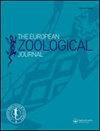Cloning and bioinformatics analysis of aquaporin proteins in the European house dust mite, Dermatophagoides pteronyssinus
IF 1.4
4区 生物学
Q2 ZOOLOGY
引用次数: 0
Abstract
Abstract Aquaporins are highly conserved water channel proteins involved in the transport of solutes across membranes. The few aquaporins identified to date play major roles in excretion in insects. Excretion is a major source of indoor allergens from the house dust mite species, but, to date, aquaporins have not been well studied in these species. We used RNA sequencing to study the transcriptome of the house dust mite Dermatophagoides pteronyssinus to identify putative aquaporin family members. RNA was isolated from more than 2000 mites for 5΄-RACE and 3΄-RACE. Putative aquaporins were identified through BLAST alignments, and primers were designed to amplify the five identified sequences. These cDNA fragments were then inserted into bacterial plasmids for molecular cloning and sequencing of DerpAQP1, DerpAQP2, DerpAQP3, DerpAQP4, and DerpAQP5 (GenBank accessions nos. KY305293, KY305294, KY305295, KY305296, and KY305298, respectively). Phylogenetic analysis of cloned sequences revealed the clustering of these putative aquaporins into two groups with human aquaporins (hAQPs): DerpAQP3 was clustered with hAQP8, hAQP11, and hAQP12; and DerpAQP1, DerpAQP2, DerpAQP4, DerpAQP5 were clustered with hAQP3, hAQP7 hAQP9, and hAQP10. This study provides a foundation for future studies of the importance of these proteins to dust mite functions and allergenicity.欧洲尘螨水通道蛋白的克隆及生物信息学分析
摘要水通道蛋白是一种高度保守的水通道蛋白,参与溶质跨膜转运。迄今为止,为数不多的水通道蛋白在昆虫排泄中发挥着重要作用。排泄物是室内尘螨类过敏原的主要来源,但迄今为止,尚未对这些物种的水通道蛋白进行充分研究。我们使用RNA测序来研究屋尘螨的转录组,以确定推定的水通道蛋白家族成员。从2000多只螨虫中分离到5个RACE和3个RACE的RNA。通过BLAST比对鉴定推测的水通道蛋白,并设计引物扩增五个已鉴定的序列。然后将这些cDNA片段插入细菌质粒中,用于DerpAQP1、DerpAQP2、DerpAquP3、DerpAQP4和DerpAQP5的分子克隆和测序(GenBank材料编号分别为KY305293、KY305294、KY305295、KY305296和KY305298)。克隆序列的系统发育分析显示,这些假定的水通道蛋白与人水通道蛋白(hAQPs)分为两组:DerpAQP3与hAQP8、hAQP11和hAQP12聚在一起;并且DerpAQP1、DerpAQP2、DerpAQP4、DerpAquP5与hAQP3、hAQP7-hAQP9和hAQP10聚集。这项研究为未来研究这些蛋白质对尘螨功能和致敏性的重要性奠定了基础。
本文章由计算机程序翻译,如有差异,请以英文原文为准。
求助全文
约1分钟内获得全文
求助全文
来源期刊

European Zoological Journal
Agricultural and Biological Sciences-Animal Science and Zoology
CiteScore
3.10
自引率
5.60%
发文量
80
审稿时长
30 weeks
期刊介绍:
The European Zoological Journal (previously Italian Journal of Zoology) is an open access journal devoted to the study of all aspects of basic, comparative and applied protozoan and animal biology at molecular, cellular, tissue, organ, organismal, population, and community-ecosystem level. Papers covering multiple levels of organization and integrative approaches to study animal form, function, development, ecology, evolution and systematics are welcome. First established in 1930 under the name of Il Bollettino di Zoologia, the journal now has an international focus, reflected through its global editorial board, and wide author and readership.
 求助内容:
求助内容: 应助结果提醒方式:
应助结果提醒方式:


